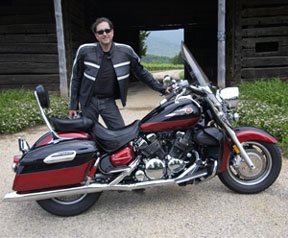 June 2002-HALF MOON BAY, CA. Buying a motorcycle is an emotional purchase tempered with minor bursts of reasoning. But for an experienced rider who’s inseam sends them to the kids department for jeans, the emotional element completely loses out to reasoning. Despite suspension lowering kits and techs that will install them, usually with some sort of liability waiver or disclaimer, short riders keep riding and keep falling over at stoplights.
June 2002-HALF MOON BAY, CA. Buying a motorcycle is an emotional purchase tempered with minor bursts of reasoning. But for an experienced rider who’s inseam sends them to the kids department for jeans, the emotional element completely loses out to reasoning. Despite suspension lowering kits and techs that will install them, usually with some sort of liability waiver or disclaimer, short riders keep riding and keep falling over at stoplights.Enter the Yamaha Road Star Warrior with its 28-inch seat height. While taking the trophy at a limbo contest was not what the Warrior’s designers had in mind when they started the project it is certainly a major benefit to a large part of the motorcycle market and for those of you not vertically challenged the low seat has another benefit; you can really raise your ass off it, far enough that your head is above the smoke from the burnouts you’ll inevitably be doing.
One part muscle bike, one part streetfighter and one part cruiser the Warrior is the two-wheeled embodiment of the timeless icon that seduced so many before it: the classic, all-American Hot Rod.
It’s 102 cubic inches translates into a 1670 cc of air-cooled V-twin engine that produces 79.9 horsepower at 4,400 rpm and 103.8 lbs/ft of torque at 3,500 rpm. The air intake system is comprised of two intake boxes, their combined volume is a massive 7.5 liters. Offering a 115% increase in volume while lowering the intake resistance by 70% when compared to earlier Yamaha cruisers.

The engine has been bored from 95 to 97 mm increasing the displacement from 1602 to 1670 cubic centimeters (stroke remains the same at 113 mm). The cylinders feature a new high-volume, two-piece head (vs. the Road Star’s three-piece head).
An engine this massive has its worst drawback when it isn’t running and you want to start it. Ever watch a guy try to start an old Harley that’s been stroked? It takes a lot of power (leg or electric) to crank that sucker, so Yamaha added the same engine decompression system as on the Road Star. Simply put it releases the valve a bit during the start-up sequence. While this works just fine the bike makes some unfamiliar sounds when you press the starter, but you’ll get used to it, after all, it’s the sound power to come.
Fuel and air are mixed in the two 40 mm downdraft throttle bodies. The mixture then passes into the cylinders via a revised cylinder head design that offers a straighter intake path. Cooling fin area has been increased to keep the Warrior from getting hot under the collar.
The muffler weighs in at 8.3 kilograms. That’s 1.6 kilograms less than the standard Road Star muffler, while increasing internal capacity by 1.8 liters to 11.5 liters. The engineers also managed to keep the front and rear manifolds on the two-into-one system within and inch and a half, balancing the back pressure close to perfect. The exhaust looks large… it is but it sounds great, offering up a note that will please the most die-hard cruiser addict.
All this engine technology is managed by a seven sensor EFI system that tracks everything from barometric pressure to front and rear cylinder temperature, the most sophisticated EFI system on two wheels. An ECU works with a throttle position sensor to meter the fuel. Three-dimensional digital CD ignition mapping ensures that the spark ignites at just the right moment, delivering crisp throttle response. This system provides a power curve that rivals high performance sport bikes.
The engine is mounted in a newly designed and stiffer double-cradle design frame, 71% stiffer and 10.5 kilograms (Warrior frame weighs 17.5 kg) lighter than the standard Road Star frame. The engine is also rigidly mounted to stiffen the frame up even more.
Just as important to the handling as the new frame is the 41-mm, R1 inspired front forks, which are adjustable for preload. In the rear a preload adjustable mono-shock connects to an all aluminum cast, extruded and rectangular pipe swing-arm that also boasts an R-1 inspired pedigree.
 Power is transferred to the super-fat 200-section rear via belt drive adopted from the original Road Star but shaved to 8.5 mm and 5-speed, wide-ratio, with multi-plate wet clutch transmission.
Power is transferred to the super-fat 200-section rear via belt drive adopted from the original Road Star but shaved to 8.5 mm and 5-speed, wide-ratio, with multi-plate wet clutch transmission.As the daylight began to wane the instrument cluster took on a light of its own. Traditional incandescents have been replaced by LEDs and that goes all the way to the taillight, which looks ineffective, until you grab the binders. A grand prix style digital bar graph tachometer sweeps across the rev range while the speedometer is nestled in a very retro looking brushed finished housing.
Looking for excellent stopping power Yamaha’s designers lifted a set of calipers from the R-1 and ditto for the diameter of the master cylinder. Sumitomo calipers bite into the two 298mm diameter front discs easily scrubbing off those few illegal mph’s you might, scratch that, WILL accumulate when you get lost in the Warrior’s personality. The single rear disc boasts similar specs. None of this will matter at all when the rubber meets the road.
While the Yamaha Warrior isn’t the first Japanese power cruiser that’s made it to our shores it has set a new standard for cruiser performance and handling.





No comments:
Post a Comment